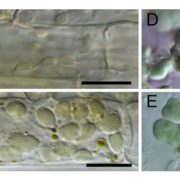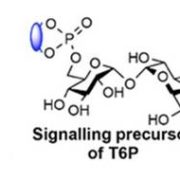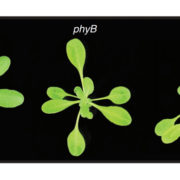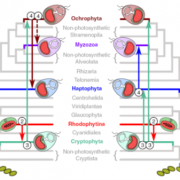Understanding the role of metabolites in the evolution of C4 photosynthesis
 Plants that use C4 photosynthesis, whereby carbon is concentrated around RuBisCo in bundle sheath cells, have high water and nitrogen use efficiencies. Thus, understanding how C4 photosynthesis evolves is of much interest. The Flaveria genus provides a unique opportunity for this, as it contains species that are classed as C3, C4, C4-like and C3-C4 intermediates. Here, Tang et al. grew 12 Flaveria species and used high-performance liquid chromatography–tandem mass spectrometry to measure the concentrations of 40 primary metabolites. Interestingly, α-ketoglutarate concentrations, when normalised to account for different chlorophyll contents, were low in C3 species, but were nearly 1000 times higher in the C3-C4 intermediate F. ramossissima, and higher again in the C4 species F. bidentis. To test whether increased α-ketoglutarate influences photosynthesis, the authors exogenously fed α-ketoglutarate to F. ramossissima petioles and saw an increase in maximum photosynthetic rate. Repeating the same experiment with a pulse of 13C labelled carbon dioxide, revealed there was faster accumulation of oxaloacetate and pyruvate, which are key C4 metabolites. Hence, increasing α-ketoglutarate concentration may be a key step in the transition to C4 photosynthesis. (Summary by Rose McNelly @Rose_McN) Plant Physiol. 10.1093/plphys/kiae077
Plants that use C4 photosynthesis, whereby carbon is concentrated around RuBisCo in bundle sheath cells, have high water and nitrogen use efficiencies. Thus, understanding how C4 photosynthesis evolves is of much interest. The Flaveria genus provides a unique opportunity for this, as it contains species that are classed as C3, C4, C4-like and C3-C4 intermediates. Here, Tang et al. grew 12 Flaveria species and used high-performance liquid chromatography–tandem mass spectrometry to measure the concentrations of 40 primary metabolites. Interestingly, α-ketoglutarate concentrations, when normalised to account for different chlorophyll contents, were low in C3 species, but were nearly 1000 times higher in the C3-C4 intermediate F. ramossissima, and higher again in the C4 species F. bidentis. To test whether increased α-ketoglutarate influences photosynthesis, the authors exogenously fed α-ketoglutarate to F. ramossissima petioles and saw an increase in maximum photosynthetic rate. Repeating the same experiment with a pulse of 13C labelled carbon dioxide, revealed there was faster accumulation of oxaloacetate and pyruvate, which are key C4 metabolites. Hence, increasing α-ketoglutarate concentration may be a key step in the transition to C4 photosynthesis. (Summary by Rose McNelly @Rose_McN) Plant Physiol. 10.1093/plphys/kiae077









